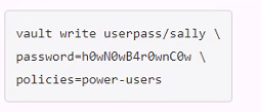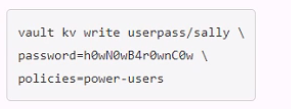Curious about Actual HashiCorp Security Automation (HCVA0-003) Exam Questions?
Here are sample HashiCorp Certified: Vault Associate (003) (HCVA0-003) Exam questions from real exam. You can get more HashiCorp Security Automation (HCVA0-003) Exam premium practice questions at TestInsights.
Your organization runs workloads on both AWS and Azure for production applications. The security team has requested that a single Vault authentication mechanism be enabled to support applications on both public cloud platforms. Which of the following would be a valid auth method you can use?
Correct : C
Comprehensive and Detailed In-Depth
AppRole is platform-agnostic. The Vault documentation states:
'Auth methods are commonly grouped into machine-based and human-based auth methods. In this case, AWS and Azure cannot be used since you can't authenticate with a single auth method across both platforms. AppRole is a Vault authentication method that allows machines or applications to authenticate with Vault using a role-specific secret ID and role ID.'
--- Vault Auth Methods
C: Correct. Works across AWS and Azure:
'It is a flexible and secure method that can be used across different cloud platforms like AWS and Azure.'
--- Vault Auth: AppRole
A, D: Platform-specific.
B: User-based, not cross-platform.
Vault Auth Methods
Vault Auth: AppRole
Topic 5, Exam Pool E
Start a Discussions
You are using the Vault userpass auth method mounted at auth/userpass. How do you create a new user named "sally" with password "h0wN0wB4r0wnC0w"? This new user will need the power-users policy.
A.

B.

C.

D.

Correct : D
To create a new user named ''sally'' with password ''h0wN0wB4r0wnC0w'' and the power-users policy, you would use the Vault userpass auth method mounted at auth/userpass. You would use the following command: ''vault write auth/userpass/users/sally password=h0wN0wB4r0wnC0w policies=power-users''. This command would create a new user named ''sally'' with the specified password and policy.Reference:
[Userpass Auth Method | Vault | HashiCorp Developer]
[Create Vault policies | Vault | HashiCorp Developer]
Start a Discussions
The vault lease renew command increments the lease time from:
Start a Discussions
You have a 2GB Base64 binary large object (blob) that needs to be encrypted. Which of the following best describes the transit secrets engine?
Correct : D
The transit secrets engine is not a good solution for binaries of this size, because it is designed to handle cryptographic functions on data in-transit, not data at-rest. The transit secrets engine does not store any data sent to it, so it would require sending the entire 2GB blob to Vault for encryption or decryption, which would be inefficient and impractical. A better solution would be to use the transit secrets engine to generate a data key, which is a high-entropy key that can be used to encrypt or decrypt data locally. The data key can be returned in plaintext or wrapped by another key, depending on the use case. This way, the transit secrets engine only handles the encryption or decryption of the data key, not the data itself, and the data can be stored in any primary data store. Reference: Transit - Secrets Engines | Vault | HashiCorp Developer, Encryption as a service: transit secrets engine | Vault | HashiCorp Developer
Start a Discussions
How would you describe the value of using the Vault transit secrets engine?
Correct : D
The transit secrets engine relieves the burden of proper encryption/decryption from application developers and pushes the burden onto the operators of Vault. The transit secrets engine provides encryption as a service, which means that it performs cryptographic operations on data in-transit without storing any data. This allows developers to delegate the responsibility of managing encryption keys and algorithms to Vault operators, who can define and enforce policies on the transit secrets engine. This way, developers can focus on their application logic and data, while Vault handles the encryption and decryption of data in a secure and scalable manner. Reference: Transit - Secrets Engines | Vault | HashiCorp Developer, Encryption as a service: transit secrets engine | Vault | HashiCorp Developer
Start a Discussions
Total 285 questions